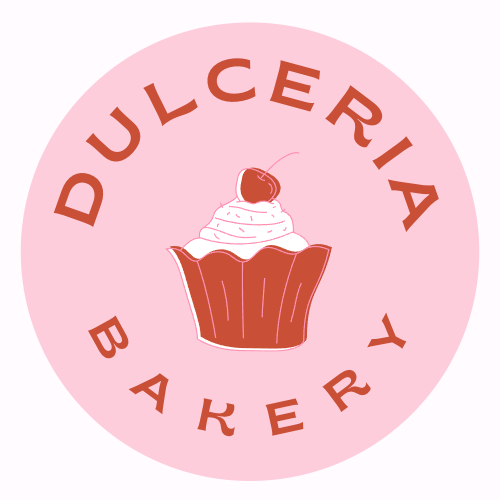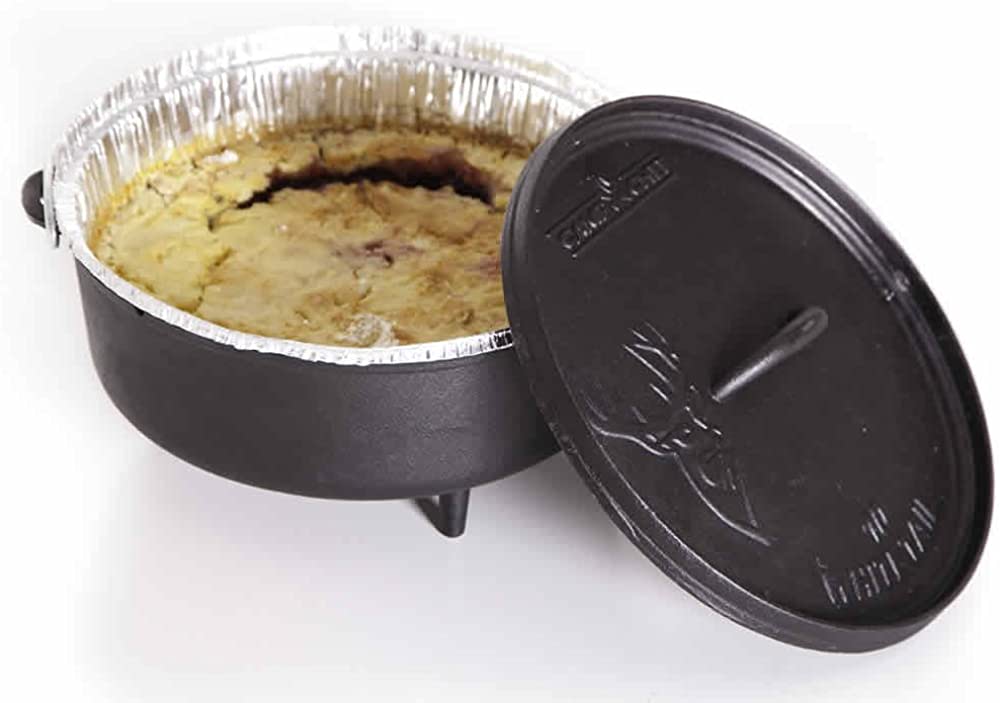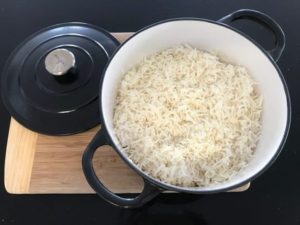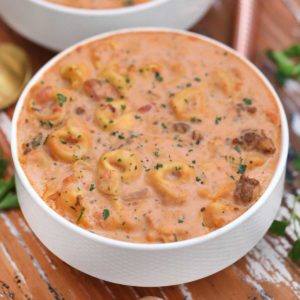Dutch oven liners are disposable or reusable liners that are designed to fit inside a Dutch oven. They are typically made from materials such as aluminum foil, parchment paper, or silicone, and are intended to make cleaning the Dutch oven easier and more convenient.
Dutch oven liners can be particularly useful when cooking foods that are sticky or messy, as they prevent the food from sticking to the surface of the Dutch oven and help to prevent burnt-on residue. They can also be used when cooking foods with strong flavors, such as garlic or onions, as the liner helps to prevent these flavors from seeping into the Dutch oven and affecting the taste of future dishes.
Dutch oven liners come in a variety of sizes and shapes to fit different types of Dutch ovens, and they are typically sold in packs of multiple liners for convenience. While some Dutch oven enthusiasts prefer to cook without liners in order to create a seasoned layer on the pot, others find that liners are a useful tool for easier cleanup and maintenance of their Dutch oven.
What do you line a Dutch oven with?
There are several materials you can use to line a Dutch oven, including:
- Aluminum Foil: This is a popular option as it is readily available and can be easily molded to fit the shape of the Dutch oven. It is also disposable, making cleanup quick and easy.
- Parchment Paper: This is another popular option as it is non-stick and can be easily removed from the Dutch oven after cooking. It is also disposable, making cleanup quick and easy.
- Silicone Liners: These are reusable liners that are made from food-grade silicone. They are durable and can be used over and over again, making them a more environmentally friendly option.
When lining a Dutch oven, be sure to choose a liner that is appropriate for the cooking temperature and type of food being cooked. Additionally, make sure the liner fits snugly inside the Dutch oven and does not interfere with the lid or cooking process.
Do Dutch oven liners work?
Yes, Dutch oven liners do work, and they can be a convenient and effective tool for cooking and cleaning Dutch ovens. The liners are designed to fit snugly inside the Dutch oven and can help prevent food from sticking to the pot, making cleanup much easier.
Many Dutch oven enthusiasts swear by the use of liners, especially when cooking foods that are particularly sticky or messy. The liners can also help prevent burnt-on residue, which can be difficult to remove, especially if the Dutch oven is not properly seasoned.
While some people prefer not to use liners in order to create a seasoned layer on their Dutch oven, others find that liners are a useful tool for maintaining the quality and longevity of the pot. Ultimately, the decision to use Dutch oven liners is a personal one and will depend on individual cooking preferences and needs.
What are Dutch oven liners made of?
Dutch oven liners are typically made from either aluminum foil or parchment paper. Some liners are also made from food-grade silicone, which is a more durable and reusable material.
Aluminum foil is a thin, flexible sheet of aluminum that can be easily molded to fit the shape of the Dutch oven. It is a popular option because it is readily available and can be easily disposed of after use.
Parchment paper is a non-stick paper that is coated with silicone to prevent food from sticking. It is also a popular option because it can be easily molded to fit the shape of the Dutch oven and is disposable.
Food-grade silicone liners are reusable and can be used over and over again. They are made from a flexible, non-stick material that is safe for use with food. They are a more eco-friendly option than disposable liners, and they can be washed and reused many times.
Benefits of using Dutch oven liners
Using Dutch oven liners can offer several benefits, including:
- Easy Cleanup: One of the primary benefits of using Dutch oven liners is that they make cleanup quick and easy. Instead of having to scrub the inside of the Dutch oven, you can simply remove the liner and dispose of it.
- Prevents Sticking: Dutch oven liners can help prevent food from sticking to the bottom of the pot, which can make cooking and cleanup easier.
- Protects the Dutch Oven: Using a liner can help protect the Dutch oven from scratches and damage, which can prolong the life of the pot.
- Versatility: Dutch oven liners can be used for a variety of cooking methods, including baking, roasting, and braising. They can also be used to cook a wide range of foods, from meats and vegetables to bread and desserts.
- Eco-Friendly Option: If you use a reusable silicone liner, you can reduce waste and be more environmentally friendly than using disposable liners.
Overall, using Dutch oven liners can help make cooking and cleanup easier and more efficient, while also protecting your Dutch oven and reducing waste.
How to make your own Dutch oven liners?
You can make your own Dutch oven liners using parchment paper or aluminum foil. Here’s how:
- Measure the inside of your Dutch oven and cut a piece of parchment paper or aluminum foil to fit the bottom and sides of the pot. You can use scissors or a knife to cut the material to size.
- Press the liner into the Dutch oven, making sure it fits snugly against the sides and bottom. You want to make sure there are no gaps or spaces that could allow food to seep through.
- Preheat the Dutch oven as directed in your recipe, then add your food and cook as usual.
- When you’re done cooking, carefully remove the food and discard the liner. If you’re using a reusable silicone liner, wash it with soap and water and store it for future use.
When making your own Dutch oven liner, be sure to use a material that is appropriate for the cooking temperature and type of food being cooked. Additionally, make sure the liner fits snugly inside the Dutch oven and does not interfere with the lid or cooking process.
What can Dutch oven liners be used for?
Dutch oven liners can be used for a variety of cooking methods and foods, including:
- Baking: Dutch oven liners can be used to bake bread, cakes, and other baked goods in a Dutch oven.
- Roasting: You can use Dutch oven liners to roast meats and vegetables in a Dutch oven.
- Braising: Dutch oven liners can also be used to braise meats and vegetables in a Dutch oven.
- Stews and Soups: You can use Dutch oven liners to make stews and soups in a Dutch oven, which can be especially useful if you’re making a recipe with a lot of ingredients.
- Desserts: Dutch oven liners can be used to make a variety of desserts, including cobblers, crisps, and even cheesecake.
When using Dutch oven liners, it’s important to make sure the liner is appropriate for the cooking method and temperature. Additionally, make sure the liner fits snugly inside the Dutch oven and does not interfere with the lid or cooking process.
How long does it take to use Dutch oven liners?
The length of time it takes to use a Dutch oven liner depends on the cooking method and the recipe you are using. Generally, using a Dutch oven liner should not add any significant time to the cooking process, as it is simply a protective layer that sits between the food and the pot.
However, if you are using a liner to make cleanup easier, it may take a few extra minutes to remove the liner and dispose of it after cooking. Similarly, if you are using a reusable silicone liner, you will need to take the time to wash and dry the liner after use.
Overall, the use of a Dutch oven liner should not significantly impact the cooking time of your recipe.
Tips for using Dutch oven liners
Here are some tips for using Dutch oven liners:
- Choose the right liner: Make sure you choose a liner that is appropriate for the cooking method and temperature. For example, a silicone liner is suitable for high-heat cooking, while a parchment paper liner may not be suitable for high temperatures.
- Use the correct size: Make sure you choose a liner that is the correct size for your Dutch oven. The liner should fit snugly inside the pot, without any gaps or loose areas.
- Prepare the liner: If you are using a parchment paper liner, it can be helpful to crumple it up first to make it more pliable and easier to fit into the Dutch oven.
- Do not cover the liner: Do not cover the liner with the Dutch oven lid or any other type of cover. The liner needs to be able to breathe and allow steam to escape during the cooking process.
- Be careful when removing: When removing the liner from the Dutch oven after cooking, be careful not to spill any hot liquids that may have accumulated inside.
- Dispose of the liner properly: If you are using a disposable liner, make sure you dispose of it properly in the trash. If you are using a reusable silicone liner, wash it thoroughly with soap and water after use.
By following these tips, you can use Dutch oven liners safely and effectively to make cooking and cleanup easier.
Related Posts
How do you cook rice in a Dutch oven?
Disclaimer: There are affiliate links in this post. At no...
Read MoreWhy use a Dutch oven for soup?
Disclaimer: There are affiliate links in this post. At no...
Read MoreHow to choose the best Dutch oven for deep frying
Disclaimer: There are affiliate links in this post. At no...
Read MoreCan you use a Dutch oven on a glass top stove?
Disclaimer: There are affiliate links in this post. At no...
Read MoreWhy Trust Us
You will find what you are looking for at dulceriabakery. From classic to luxury brands, you'll find both. We will help you to select appliances that fit your needs, budget and lifestyle. Whether you want to stop by to learn more — or plan to make a major purchase — we’ll treat you like family and assist you every step of the way. Shop with us today to receive friendly and experienced help along the way.





